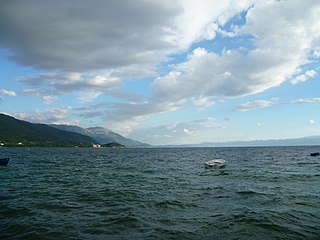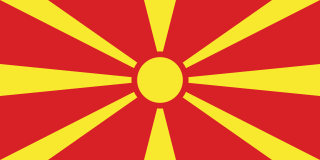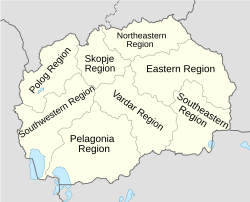
Demographic features of the population of North Macedonia include population density, ethnicity, education level, health of the populace, economic status, religious affiliations and other aspects of the population.

Central Macedonia is one of the thirteen administrative regions of Greece, consisting of the central part of the geographical and historical region of Macedonia. With a population of almost 1.8 million, it is the second most populous region in Greece after Attica.

Western Macedonia is one of the thirteen administrative regions of Greece, consisting of the western part of Macedonia. Located in north-western Greece, it is divided into the regional units of Florina, Grevena, Kastoria, and Kozani. With a population of approximately 255,000 people, as of 2021, the region had one of the highest unemployment rates in the European Union.

Central Serbia, also referred to as Serbia proper, is the region of Serbia lying outside the autonomous province of Vojvodina to the north and the disputed Kosovo region to the south. Central Serbia is a term of convenience, not an administrative division of Serbia as such, and does not have any form of separate administration.

Macedonia is a geographic and former administrative region of Greece, in the southern Balkans. Macedonia is the largest and second-most-populous geographic region in Greece, with a population of 2.36 million. It is highly mountainous, with major urban centres such as Thessaloniki and Kavala being concentrated on its southern coastline. Together with Thrace, along with Thessaly and Epirus occasionally, it is part of Northern Greece. Greek Macedonia encompasses entirely the southern part of the wider region of Macedonia, making up 51% of the total area of that region. Additionally, it widely constitutes Greece's borders with three countries: Albania to the northwest, North Macedonia to the north, and Bulgaria to the northeast.

The municipalities are the first-order administrative divisions of North Macedonia.

Muslims in North Macedonia represent just under one-third of the nation's total population according to the 2021 census, making Islam the second most widely professed religion in the country. Muslims in North Macedonia follow Sunni Islam of the Hanafi madhhab. Some northwestern and western regions of the country have Muslim majorities. A large majority of all the Muslims in the country are ethnic Albanians, with the rest being primarily Turks, Romani, Bosniaks or Torbeš.

Centar Župa is a municipality in the western part of North Macedonia. Centar Župa is also the name of the village where the municipal seat is found. Centar Župa Municipality is part of the Southwestern Statistical Region.

The Skopje Statistical Region is one of eight statistical regions of North Macedonia. The region is located in the north of the country, bordering Kosovo. Internally, it borders the Vardar, Polog, Northeastern, Eastern, and Southwestern statistical regions.

The Pelagonia Statistical Region is one of eight statistical regions of North Macedonia. It is located in southwestern part of the country along the eponymous plain. It borders Greece and Albania. Internally, it borders the Southwestern and Vardar statistical regions.

The Southwestern Statistical Region is one of eight statistical regions of North Macedonia. Southwestern, located in the western part of the country, sharing Ohrid Lake with its westerly border Albania. Internally, it borders the Pelagonia, Polog, Skopje, and Vardar statistical regions.

The Polog Statistical Region is one of eight statistical regions of the Republic of North Macedonia. Polog, located in the northwestern part of the country, borders Albania and Kosovo. Internally, it borders the Southwestern and Skopje statistical regions.

The Northeastern Statistical Region is one of eight statistical regions in North Macedonia. It borders Kosovo and Serbia to the north and Bulgaria to the east, while internally, it borders the Skopje and Eastern statistical regions.

The Vardar Statistical Region is one of eight statistical regions of North Macedonia. Vardar, located in the central part of North Macedonia, borders Greece to the south. Internally, it borders the Pelagonia, Southwestern, Skopje, Southeastern, and Eastern. The Vardar Statistical Region is named after the Vardar River, which runs through the region.

The Southeastern Statistical Region is one of eight statistical regions of North Macedonia. Southeastern, located in the southeastern part of the country, borders Greece and Bulgaria. Internally, it borders the Vardar and Eastern statistical regions.

The Eastern Statistical Region is one of eight statistical regions of North Macedonia. Eastern, located in the eastern part of the country, borders Bulgaria. Internally, it borders the Vardar, Skopje, Northeastern, and Southeastern statistical regions.

North Macedonia, officially the Republic of North Macedonia, is a landlocked country in Southeast Europe. It shares land borders with Greece to the south, Albania to the west, Bulgaria to the east, Kosovo to the northwest and Serbia to the north. It constitutes approximately the northern third of the larger geographical region of Macedonia. Skopje, the capital and largest city, is home to a quarter of the country's population of 1.83 million. The majority of the residents are ethnic Macedonians, a South Slavic people. Albanians form a significant minority at around 25%, followed by Turks, Roma, Serbs, Bosniaks, Aromanians and a few other minorities.
The Republic of North Macedonia is currently divided into 8 statistical regions, 80 municipalities and 1783 settlements as of July 2021.
As a candidate country of the European Union, North Macedonia (MK) is included in the Nomenclature of Territorial Units for Statistics (NUTS). The three NUTS levels are:

Northern Greece is used to refer to the northern parts of Greece, and can have various definitions.


















